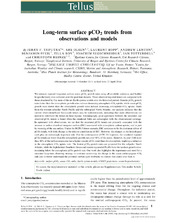| dc.contributor.author | Tjiputra, Jerry | eng |
| dc.contributor.author | Olsen, Are | eng |
| dc.contributor.author | Bopp, Laurent | eng |
| dc.contributor.author | Lenton, Andrew | eng |
| dc.contributor.author | Pfeil, Benjamin | eng |
| dc.contributor.author | Roy, Tilla | eng |
| dc.contributor.author | Segschneider, Joachim | eng |
| dc.contributor.author | Totterdell, Ian | eng |
| dc.contributor.author | Heinze, Christoph | eng |
| dc.date.accessioned | 2015-04-13T07:38:34Z | |
| dc.date.available | 2015-04-13T07:38:34Z | |
| dc.date.issued | 2014-05-19 | eng |
| dc.identifier.issn | 0280-6509 | en_US |
| dc.identifier.uri | https://hdl.handle.net/1956/9764 | |
| dc.description.abstract | We estimate regional long-term surface ocean pCO2 growth rates using all available underway and bottled biogeochemistry data collected over the past four decades. These observed regional trends are compared with those simulated by five state-of-the-art Earth system models over the historical period. Oceanic pCO2 growth rates faster than the atmospheric growth rates indicate decreasing atmospheric CO2 uptake, while ocean pCO2 growth rates slower than the atmospheric growth rates indicate increasing atmospheric CO2 uptake. Aside from the western subpolar North Pacific and the subtropical North Atlantic, our analysis indicates that the current observation-based basin-scale trends may be underestimated, indicating that more observations are needed to determine the trends in these regions. Encouragingly, good agreement between the simulated and observed pCO2 trends is found when the simulated fields are subsampled with the observational coverage. In agreement with observations, we see that the simulated pCO2 trends are primarily associated with the increase in surface dissolved inorganic carbon (DIC) associated with atmospheric carbon uptake, and in part by warming of the sea surface. Under the RCP8.5 future scenario, DIC continues to be the dominant driver of pCO2 trends, with little change in the relative contribution of SST. However, the changes in the hydrological cycle play an increasingly important role. For the contemporary (1970–2011) period, the simulated regional pCO2 trends are lower than the atmospheric growth rate over 90% of the ocean. However, by year 2100 more than 40% of the surface ocean area has a higher oceanic pCO2 trend than the atmosphere, implying a reduction in the atmospheric CO2 uptake rate. The fastest pCO2 growth rates are projected for the subpolar North Atlantic, while the high-latitude Southern Ocean and eastern equatorial Pacific have the weakest growth rates, remaining below the atmospheric pCO2 growth rate. Our work also highlights the importance and need for a sustained long-term observing strategy to continue monitoring the change in the ocean anthropogenic CO2 sink and to better understand the potential carbon cycle feedbacks to climate that could arise from it. | en_US |
| dc.language.iso | eng | eng |
| dc.publisher | Co-Action Publishing | en_US |
| dc.publisher | The International Meteorological Institute in Stockholm | en_US |
| dc.rights | Attribution CC BY | eng |
| dc.rights.uri | http://creativecommons.org/licenses/by/4.0/ | eng |
| dc.subject | surface pCO2 | eng |
| dc.subject | ocean CO2 sinks | eng |
| dc.subject | Earth system models | eng |
| dc.subject | CMIP5 projections | eng |
| dc.subject | ocean biogeochemistry | eng |
| dc.title | Long-term surface pCO2 trends from observations and models | en_US |
| dc.type | Peer reviewed | |
| dc.type | Journal article | |
| dc.date.updated | 2015-04-01T10:11:45Z | en_US |
| dc.description.version | publishedVersion | en_US |
| dc.rights.holder | Copyright 2014 J. F. Tjiputra et al. | en_US |
| dc.source.articlenumber | 23083 | |
| dc.identifier.doi | https://doi.org/10.3402/tellusb.v66.23083 | |
| dc.identifier.cristin | 1134509 | |
| dc.source.journal | Tellus. Series B, Chemical and physical meteorology | |
| dc.source.40 | 66 | |
| dc.relation.project | NorStore: NS2980K | |
| dc.relation.project | Norges forskningsråd: EARTHCLIM 207711/E10 | |
| dc.relation.project | Notur: NN2980K | |
| dc.relation.project | EU: CARBOCHANGE 264879 | |
| dc.relation.project | NorStore: NS2345K | |
| dc.relation.project | Notur: NN2345K | |
| dc.subject.nsi | VDP::Mathematics and natural scienses: 400::Geosciences: 450::Meteorology: 453 | en_US |
| dc.subject.nsi | VDP::Mathematics and natural scienses: 400::Geosciences: 450::Oceanography: 452 | en_US |
| dc.subject.nsi | VDP::Matematikk og naturvitenskap: 400::Geofag: 450::Meteorologi: 453 | nob |
| dc.subject.nsi | VDP::Matematikk og naturvitenskap: 400::Geofag: 450::Oseanografi: 452 | nob |

